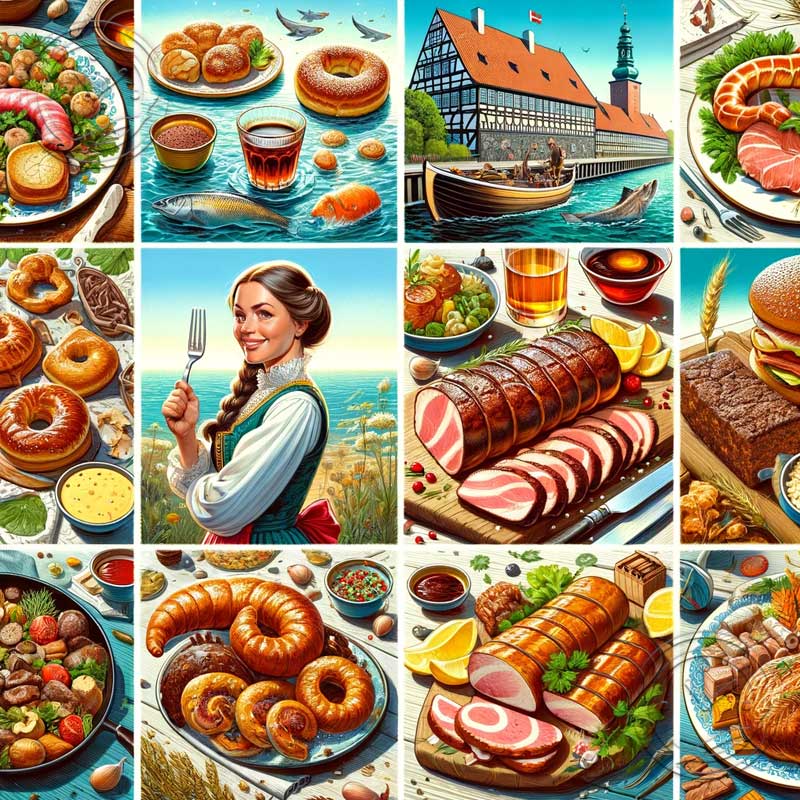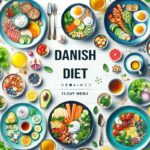History of Danish Cuisine
The history of Danish cuisine is long and complex, with influences from a variety of cultures. The earliest evidence of food in Denmark dates back to the Stone Age, when hunter-gatherers would eat wild game, fish, and berries. With the arrival of farming in the Neolithic period, people began to grow crops and raise livestock, which added a new variety of foods to the Danish diet.
During the Viking Age, Danish cuisine was heavily influenced by the cultures of the countries that the Vikings visited, including Norway, Sweden, England, and France. This period saw the introduction of new foods such as bread, cheese, and wine.
After the Viking Age, Denmark was ruled by a series of kings who brought their own culinary traditions to the country. This period saw the introduction of new dishes such as roast pork, smoked eel, and pickled herring.
In the 16th century, Denmark was introduced to the New World by explorer Hans Christian Andersen. This brought a new wave of influences to Danish cuisine, including corn, tomatoes, and potatoes.
In the 18th century, Denmark experienced a period of economic growth and prosperity, which led to a rise in the popularity of fine dining. This period saw the introduction of new dishes such as foie gras, truffles, and champagne.
In the 19th century, Denmark was hit by a series of economic crises, which led to a decline in the popularity of fine dining. This period saw a return to more traditional Danish dishes such as smørrebrød and frikadeller.
In the 20th century, Denmark experienced a period of peace and prosperity, which led to a renewed interest in traditional Danish cuisine. This period saw the rise of new dishes such as stegt flæsk med persillesovs and æblekage.
Today, Danish cuisine is a fusion of traditional Danish dishes with influences from around the world. It is a rich and varied cuisine that is enjoyed by people all over the world.
Traditional Foods in Danish Diet
The traditional foods in Danish diet are:
- Bread:
- Rug bread
- White bread
- Boller (sweet rolls)
- Meat dishes:
- Frikadeller (Danish meatballs)
- Flæskesteg (roast pork)
- Medisterpølse (sausage)
- Fish dishes:
- Fiskefileter (fish fillets)
- Røget laks (smoked salmon)
- Sild (herring)
- Vegetable dishes:
- Kartofler (potatoes)
- Grøntsager (vegetables)
- Rødkål (red cabbage)
- Dairy dishes:
- Mælk (milk)
- Yoghurt
- Fløde (cream)
- Desserts:
- Æblekage (apple pie)
- Brunsviger (cinnamon bun)
- Hvedekage (wheat cake)
- Drinks:
- Øl (beer)
- Vin
- Squash
Danish Diet for Diabetes Control
Discover the Danish Diet, a powerful ally in managing diabetes and promoting overall health. Based on the wholesome traditions of…
Meat Dishes
Meat is a staple of Danish cuisine, and there are many traditional dishes that feature pork, beef, lamb, and game. Some of the most popular meat dishes include:
- Flæskesteg (roast pork)
- Frikadeller (Danish meatballs)
- Medisterpølse (blood sausage)
- Stegemad (grilled meat)
- Kødgryde (stew)
These dishes are typically served with potatoes, vegetables, and a sauce. They are often enjoyed as part of a smørrebrød (open-faced sandwich) or as a main course.
Fish Dishes in Danish Cuisine
Fish is a popular ingredient in Danish cuisine, and there are many different ways to prepare it. Some of the most popular fish dishes include:
- Fiskefileter (fish fillets) are often pan-fried or grilled and served with a variety of sauces.
- Biksemad (fish stew) is a hearty dish made with fish, potatoes, and vegetables.
- Frikadeller (fish cakes) are made with ground fish, bread crumbs, and eggs.
- Smørrebrød (open-faced sandwiches) often feature fish as the main ingredient.
- Røget laks (smoked salmon) is a popular cured fish that is often served as a cold appetizer.
Fish is a healthy and delicious way to add variety to your diet. Whether you’re looking for a simple weeknight meal or a special occasion dish, there’s sure to be a fish dish that you’ll enjoy.
The Danish diet has been linked to a number of health benefits, including a reduced risk of heart disease, stroke,…
Vegetable Dishes
Vegetables are an important part of the Danish diet, and there are many traditional vegetable dishes that are enjoyed throughout the country.
- One of the most popular vegetable dishes in Denmark is stegt flæsk, which is pork belly that is fried until it is crispy. It is typically served with boiled potatoes, parsley sauce, and pickled red cabbage.
- Another popular vegetable dish is rødbedesalat, which is a salad made with beets, carrots, red onions, and parsley. It is typically served with a creamy dressing.
- Grønkålssalat is a salad made with kale, apples, and walnuts. It is typically served with a vinaigrette dressing.
- Kartoffelsalat is a potato salad that is typically made with boiled potatoes, mayonnaise, and bacon. It is often served as a side dish to grilled meats.
- Sild is a pickled herring that is a popular snack in Denmark. It is typically served with boiled potatoes, pickled red onions, and remoulade sauce.
In addition to these traditional dishes, there are also many other ways to enjoy vegetables in Danish cuisine. Vegetables are often used in soups, stews, and casseroles. They are also used in salads, sandwiches, and wraps.
Vegetables are a healthy and delicious way to add variety to your diet. They are a good source of vitamins, minerals, and fiber. Eating plenty of vegetables can help you maintain a healthy weight and reduce your risk of chronic diseases such as heart disease, stroke, and cancer.
Dairy Dishes
Dairy dishes are a staple of Danish cuisine, and there are many different types to choose from. Some of the most popular dairy dishes include:
- Rødgrød med fløde – This is a traditional Danish dessert made with red berries, sugar, and cream. It is often served with a dollop of whipped cream on top.
- Ymer – This is a fermented milk drink that is similar to yogurt. It is often served with sugar, cinnamon, and cardamom.
- Arla skyr – This is a type of strained yogurt that is made from skim milk. It is often used as a healthier alternative to sour cream or heavy cream.
- Flødebolle – This is a Danish pastry that is made with a meringue shell filled with whipped cream and chocolate.
- Koldskål – This is a cold soup made with milk, cream, sugar, and vanilla. It is often served with a topping of crumbled biscuits or cookies.
Dairy dishes are a delicious and nutritious way to enjoy the flavors of Denmark. They are also a great way to stay cool and refreshed on a hot summer day.
Discover the Danish Diet, a proven path to shedding pounds and enhancing your well-being. This popular weight loss regimen, inspired…
Breads and Pastries
Danish breads and pastries are a delicious and essential part of the country’s cuisine. They are often made with rye flour, which gives them a distinctive flavor and texture.
- Rug bread (rugbrød) is a dark, dense bread made with rye flour, sourdough starter, and caraway seeds. It is a popular everyday bread in Denmark and is often served with butter, cheese, and cold cuts.
- Smørrebrød is a traditional open-faced sandwich made with rye bread, butter, and a variety of toppings, such as ham, cheese, fish, and vegetables. Smørrebrød is often served as a light meal or snack.
- Leverpostej is a type of liver pâté that is often served on smørrebrød. It is made with pork liver, bacon, onions, and spices.
- Flæskesteg is a roast pork dish that is typically served with crackling, potatoes, and red cabbage. It is a popular dish for Christmas and other special occasions.
- Kartofler (potatoes) are a staple of the Danish diet and are often served boiled, mashed, or fried.
- Rødkål (red cabbage) is a traditional side dish that is made with red cabbage, apples, vinegar, and sugar.
- Remoulade is a creamy sauce that is made with mayonnaise, mustard, capers, pickles, and herbs. It is often served with fish dishes.
- Brunsviger is a traditional Danish cake that is made with layers of yeast dough, brown sugar, and cinnamon. It is a popular dessert for Christmas and other special occasions.
- Æblekage is a type of apple pie that is made with a layer of pastry, apples, and custard. It is a popular dessert in Denmark and is often served with whipped cream.
Danish breads and pastries are a delicious and versatile way to enjoy the flavors of Denmark. They can be enjoyed for breakfast, lunch, dinner, or dessert.
Desserts
Desserts are an important part of Danish cuisine, and there are many traditional desserts that are enjoyed throughout the country.
- Æblekage is a classic Danish dessert made with apples, sugar, cinnamon, and cream. It is often served with a dollop of whipped cream.
- Rødgrød med fløde is a type of fruit soup made with red currants, raspberries, and strawberries. It is typically served with a scoop of vanilla ice cream.
- Flæskestegssalat is a salad made with roast pork, potatoes, red cabbage, and pickled beets. It is often served with a dressing made with mayonnaise, vinegar, and sugar.
- Brunsviger is a type of Danish pastry that is made with yeast dough, brown sugar, and cinnamon. It is typically served with a dusting of powdered sugar.
- Æbleskiver are small, round pancakes that are made with apples, flour, sugar, and eggs. They are typically served with a dusting of powdered sugar and a sauce made with butter, sugar, and cinnamon.
These are just a few of the many delicious desserts that are enjoyed in Denmark. If you are ever in the country, be sure to try some of these traditional desserts for yourself!
Drinks
Danish people enjoy a wide variety of drinks, both alcoholic and non-alcoholic. Some of the most popular alcoholic drinks include beer, akvavit, snaps, and wine. Non-alcoholic drinks include coffee, tea, milk, and juice.
- Beer is the most popular alcoholic drink in Denmark. There are many different types of beer available, including pilsner, lager, and ale.
- Akvavit is a distilled spirit made from potatoes or grain. It is flavored with caraway seeds, and it is typically served chilled.
- Snaps is a type of flavored schnapps that is made from a variety of ingredients, including herbs, spices, and fruits. It is typically served chilled.
- Wine is also popular in Denmark, and there are many Danish wineries that produce a variety of wines.
In addition to alcoholic drinks, Danes also enjoy a variety of non-alcoholic drinks. Some of the most popular non-alcoholic drinks include coffee, tea, milk, and juice.
- Coffee is the most popular non-alcoholic drink in Denmark. It is typically served with milk and sugar.
- Tea is also popular in Denmark, and it is typically served with milk and sugar.
- Milk is a popular drink for breakfast and lunch. It is also used in many Danish dishes.
- Juice is a popular drink for breakfast and lunch. It is also used in many Danish dishes.
Danish people enjoy a wide variety of drinks, both alcoholic and non-alcoholic. These drinks are an important part of Danish culture and cuisine.
Special Occasion Foods
In addition to the traditional foods that are eaten on a daily basis, there are a number of special occasion foods that are enjoyed by Danes. These foods are often associated with specific holidays or celebrations, and they can be found on menus at restaurants and in homes throughout the country.
- Risotto with shrimp is a popular dish for Christmas Eve. It is made with a creamy risotto base, shrimp, and a variety of vegetables.
- Æbleskiver are small, round pancakes that are traditionally eaten on Shrove Tuesday. They are made with a batter that includes flour, eggs, milk, and sugar, and they are fried in hot oil.
- Flæskesteg is a roast pork dish that is often served on New Year’s Eve. It is made with a pork loin that is roasted until it is golden brown and crispy on the outside and juicy on the inside.
- Rødgrød med fløde is a traditional Danish dessert that is made with red currants, sugar, and cream. It is often served with a dollop of whipped cream on top.
- Karbonader are Danish meatballs that are made with ground beef, bread crumbs, and eggs. They are often served with a brown sauce and potatoes.
These are just a few of the many special occasion foods that are enjoyed in Denmark. Whether you are celebrating a holiday or simply looking for a delicious meal, these dishes are sure to please.

Regional Variations in Danish Cuisine
Danish cuisine varies from region to region, with each region having its own unique dishes and ingredients. Some of the most popular regional variations include:
- The Jutland region is known for its hearty dishes, such as flæskesteg (roast pork) and biksemad (hash).
- The Funen region is known for its seafood dishes, such as fiskefrikadeller (fish croquettes) and blåmuslinger (blue mussels).
- The Zealand region is known for its smørrebrød (open-faced sandwiches), which are often topped with smoked salmon, pickled herring, or other seafood.
- The Bornholm region is known for its unique dishes, such as Ærøslag (a type of pancake) and røget laks (smoked salmon).
In addition to these regional variations, there are also many different dishes that are popular throughout Denmark. Some of the most popular Danish dishes include:
- Smørrebrød (open-faced sandwiches)
- Frikadeller (Danish meatballs)
- Leverpostej (liver pâté)
- Flæskesteg (roast pork)
- Kartofler (potatoes)
- Rødkål (red cabbage)
- Remoulade (a type of tartar sauce)
- Brunsviger (a type of cinnamon bun)
- Æblekage (apple pie)
These are just a few of the many delicious dishes that are enjoyed in Denmark. Whether you’re looking for a hearty meal or a light snack, there’s sure to be something to your taste in Danish cuisine.
Conclusion
Danish cuisine is a rich and varied cuisine that reflects the country’s history and geography.
Traditional Danish foods are made with fresh, local ingredients and often feature pork, potatoes, and cabbage.
Some of the most popular Danish dishes include smørrebrød, frikadeller, and flæskesteg.
Danish cuisine is also known for its pastries and breads, such as wienerbrød and rugbrød.
If you’re ever in Denmark, be sure to try some of the traditional dishes!







